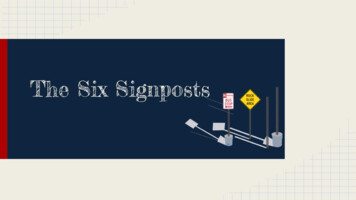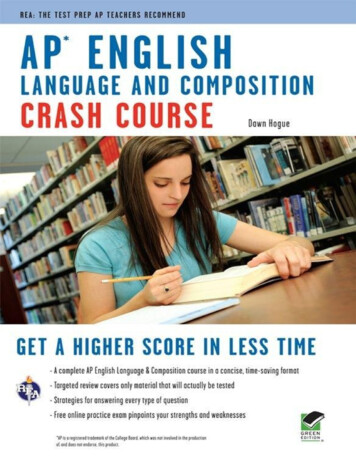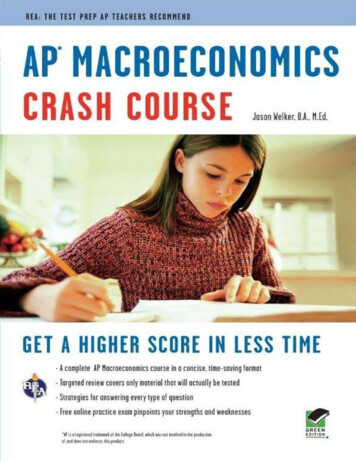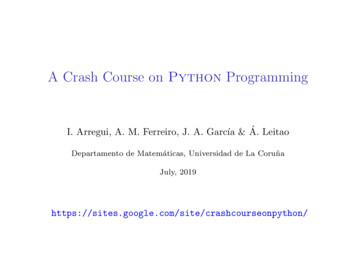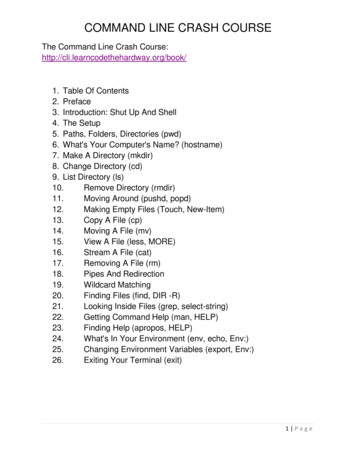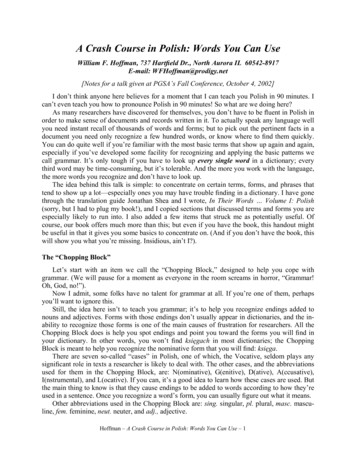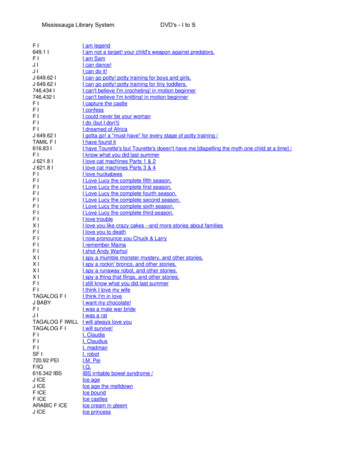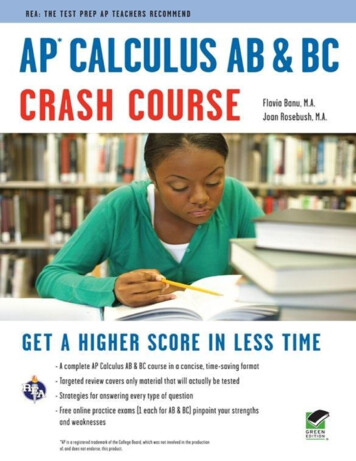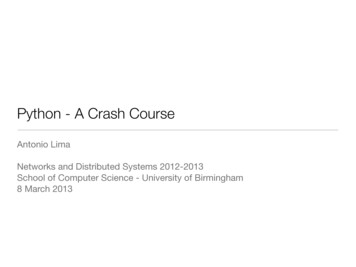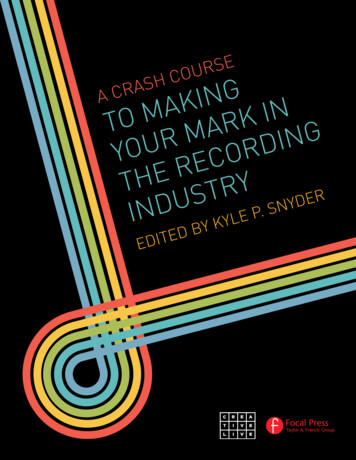
Transcription
ESROUCHSCRAGNIKANIMKTORAGMNRIYOU ECORDRETH STRYREDYUNSD.PNIELYKBYADETIED
TABLE OF CONTENTS1INTRODUCTION / HOW TO USE THIS BOOK:0422.12.22.3UNDERSTANDING THE MUSIC BUSINESSMUSIC BUSINESS 101UNDERSTANDING COPYRIGHT & LICENSINGMAKING MONEY IN THE MUSIC BUSINESS::::1011183133.13.23.33.43.5AUDIO FUNDAMENTALSSOUND AND HEARINGTHE RECORDING SPACESIGNAL FLOW: CABLES AND CONNECTIONSMICROPHONESEQUIPMENT CONSIDERATIONS: 40: 41: 72: 101: 114: 13244.14.2PRE-PRODUCTIONPLANNING AS AN ARTISTPLANNING AS AN ENGINEER: 153: 154: 15855.15.25.3PRODUCTIONMICROPHONE TECHNIQUESINSTRUMENT-SPECIFIC TECHNIQUES & ROOM SETUPSTUDIO PROCEDURES::::16917018421866.16.26.36.46.5POST PRODUCTIONAUDIO EDITING 101PRO TOOLS 101WORKING WITH BEATS, LOOPS & MIDIMIXINGMASTERING & DISTRIBUTION::::::227228280312347384
about the editorKY LE P. SN YD ERKyle P. Snyder is an educator, engineer, and consultant dedicated to the advancementof audio education for engineers at every stage of development. He is a faculty memberwithin the Ohio University School of Media Arts & Studies where he routinely teachesmusic production, recording, mixing and mastering, critical listening, sound design forfilm and video, and live event production. Snyder is also the Associate Director of OhioUniversity’s High School Media Workshop, a unique opportunity which affords buddingmedia creators the chance to test the waters for a few days while learning the latesttechniques in audio & music, video, animation, and social media.Professionally, Snyder is active in numerous organizations, including the AudioEngineering Society which he serves both internationally and locally. He is also proudto host and engineer the AES Journal Podcast, produced ten times each year inconjunction with the Journal of the Audio Engineering Society. Additionally, Snyder isa member of The National Academy of Recording Arts & Sciences, The Society ofProfessional Audio Recording Services, The Association for the Study of the Art ofRecord Production, and the Music & Entertainment Industry Educators Association.Learn more about Kyle P. Snyder including recent writings and projects in traditionalstudio recording as well as classical recording, oral history, and acoustic ecology atwww.kpsnyder.com.FOCAL PRESS3C R E AT I V E L I V E
CHAPTER1INTRODUCTION
1introductionHO W TO US E TH IS BO OKWe all have to start somewhere with audio but it’s often not where we wind up. Askedwhen I first began “studying” audio (i.e., plugging things into a 16-channel mixer andhoping it didn’t blow up), I’d have told you my big dream was to tour the world as alive engineer. Certainly I never would have predicted gravitating toward studio worklet alone teaching! My own career path, which has been filled with varied twists andturns, has shown me the true difficulties of educating anyone about audio— no twopeople have quite the same collection of prior knowledge and life experiences; fewerstill will require the exact same skills later in life. Thus, creating a book on audio andrecording that’s perfect for any one person is nearly impossible. When we break intothis field (and long after), we go about it in our own unique way; that is why I’m eagerto share this book with you. The resources you’ll find in the following pages weredesigned to help you quickly understand a topic and best achieve success in ourtumultuous, ever-changing world.With this innovative eBook companion to creativeLIVE’s unique online offerings,we’ve been able to offer you the best possible information across every topicimaginable in the recording industry in a format which finally makes sense. Think ofthis as a guidebook — an instruction manual, if you will.What does that mean? Fair question! The way this book has been designed, it dividesessential tasks and topics within the industry into more manageable, distinct sections:1. INTRODUCTION / HOW TO USE THIS BOOK2. UNDERSTANDING THE MUSIC BUSINESSThis section is a primer on the various roles found throughout the music businesstoday and the role your project studio plays in its ever-changing success. It includes ahigh-level explanation of what beginners in the field need to know when it comes tolicensing both their own and clients’ music in the world of DIY, especially issues likefair use and sampling. It concludes with a brief discussion of what each individualworking in audio needs to understand to begin monetizing his or her work, whetherhe or she is a trained audio professional or a garage-band enthusiast.FOCAL PRESS5C R E AT I V E L I V E
1introductionHO W TO US E TH IS BO OK3. AUDIO FUNDAMENTALSEngage here with a brief discussion of audio in various forms. It is exceedinglyimportant that we understand the core tenants of audio, without which understandingwhy a microphone works becomes difficult. We’ll also discuss the recording space in itsvarious forms along with important considerations in play when creating an appropriatemonitoring environment. Many individuals have made truly phenomenal recordings innothing but a garage with sparse soundproofing while others have recorded in the mostisolated rooms imaginable that they built themselves. No matter what your interest,commitment, or level of expertise is, we’ll discuss the various options available forsoundproofing; different ways in which to make a recording space and control roompossible at different budgetary levels; and the interplay of other factors upon decisionmaking such as the musical genre being recorded.The latter half of this section focuses on audio equipment in one way or another. Howdoes audio flow from device A to device B? Is it really that simple? What principles arein play, and what should the end-user be aware of? This section covers the myriad ofaudio connection standards that are bound to be encountered and more. Similarly,are all microphones created equal? Do you use certain microphones for specifictasks? An understandable yet comprehensive microphone selection guide will beprovided. Finally, while the tools of the trade change at a drastic pace, we run throughseveral different recommendations for studios operating in-the-box to on-locationand everything in between.4. PRE-PRODUCTIONIn “Understanding The Music Business” we discuss the various roles that existthroughout the music business; which one of these hats will you be wearing? Will yoube engineering as well as producing (or even playing)? We’ll talk about how theseseemingly disparate roles interconnect once everyone (or just one person) enters thestudio and how to make it all work. Speaking of entering the studio, prior to hittingrecord, there’s actually a great deal of work that can and should be done. In fact, themore effort that’s put into pre-production the more successful your session is likelyto be. So, let’s evaluate what needs to be recorded. We must be familiar with themusic itself, the instruments (a new one will occasionally surprise me still to thisday) and certainly the recording space, if this is a remote job. Once we’re familiar withthe session’s needs, we can make a plan: from an input list to a basic sessiondiagram, these can make setup a breeze.FOCAL PRESS6C R E AT I V E L I V E
1introductionHO W TO US E TH IS BO OK5. PRODUCTIONAt long last, we’re finally going to record! So, how do we actually accomplish this? Abasic understanding of the various microphone techniques used for vocals, guitar,drums, and other common instruments are an excellent starting place. Along withproper microphone techniques, what is the best way to set up your room? Given thatmost entry-level studios have only one live room (and it’s not uncommon to track inthe control room), how can we control the bleed between instruments whilemaintaining a great vibe throughout the session, etc.? We’ll discuss this along withimportant procedures worth following which make a session run smoothly before,during, and after the last note has been played. While every session is different fromthe last, these basic principles will serve you well.6. POST PRODUCTIONWith the recording session now over, it’s time to explore one last substantial hurdle—editing numerous takes into one final, cohesive product. Many editing techniques areapplicable across all workstations which we discuss first; however, given the ubiquityof Pro Tools as a mixing and editing environment, it seems particularly prudent toinclude a dedicated introduction to this digital audio workstation, an industrystandard which everyone should make themselves familiar with.Other tools and electronic instruments which can especially benefit project studioswarrant a more in-depth examination within this section. We also discuss theappropriate mixing techniques for your project once the edits have been completed toensure that everything sits correctly in the final mix before it’s sent out into the world.Finally, given ideal circumstances, a mix would be sent out for mastering and then besent on to distribution through any number of channels. However, today’s project studioengineer is often saddled with this additional responsibility. We’ll discuss the pros andcons of each path as well as how to prepare for and handle these and other challenges.FOCAL PRESS7C R E AT I V E L I V E
1introductionHO W TO US E TH IS BO OKThis book is divided, not necessarily by types of knowledge (analog, digital, and so on)but, by the types of tasks you’re likely to face in the order you’re likely to face them.We know that a predominant number of engineers learn well by actually performingthe task at hand (learning by doing, if you will) which is why I was driven to design thisas a guidebook; by starting at the beginning and working through to the end you’recertain to find yourself well-educated on the fundamentals of audio as well as theappropriate techniques required by nearly every challenge you’re likely to face.Moreover, this book was also designed as a tool for those who prefer to learn a giventask when it comes up. Though some may jump straight to this text, many may bemore inclined to learn through online tutorials, using this as an occasional resource.This is why we have strived to ensure that task-specific sections exist to help youthrough immediate questions, whether they come up while watching a creativeLIVEclass or setting up for a session.Finally, while we do start somewhere in audio, know that our journeys never end.Whether this book is your first look at the topic or yet another step towardself-improvement, I challenge you to become a lifelong learner because even thegreatest engineers continue to hone their skills with every passing day. For some,this may mean studying the history of our industry, becoming involved in professionalorganizations, participating in online communities, or just collaborating with friends.I encourage you to seek out each of these opportunities when available as they canonly further improve your education.This collaboration between Focal Press and creativeLIVE is unique because it hasallowed me to put before you what I feel is the most valuable information on a giventopic, pulling from the depths of experience that Focal Press authors have to offer.If you enjoy what a particular author has to say about audio, I encourage you to readhis or her entire book about which you can learn more at www.focalpress.com/audio.KYLE P. SNYDERwww.kpsnyder.comFOCAL PRESS8C R E AT I V E L I V E
TO GO BEYOND A CRASH COURSETO MAKING YOUR MARK IN THE RECORDING INDUSTRY,CHECK OUT THESE FOCAL PRESS TITLESUSE DISCOUNT CODE AUDIO FOR 20% OFF ALL FOCAL PRESS TITLESAUDIO UNDONEPowered by Focal Press authors and industry experts,featuring essential resources for people who live and breathe audio. CLICK HERE
CHAPTER2UNDERSTANDINGTHE MUSIC BUSINESS
2.1B u s in e s sicsuMehTgU n d e r s ta n d inMU SIC BU SIN ES S 10 1The following is excerpted fromModern Recording Techniques byDavid Miles Huber and Robert E. Runstein. 2013 Taylor and Francis Group.All rights reserved.You can purchase a copy HER E .When you get right down to the important stuff, the recording field is built aroundpools of talented individuals and service industries who work together toward acommon goal: producing, selling and enjoying music. As such, it’s the people in therecording industry who make the business of music happen. Recording studios andother businesses in the industry aren’t only known for the equipment that they havebut are often judged by the quality, knowledge, vision and combined personalities oftheir staff. The following sections describe but a few of the ways in which a personcan be involved in this multifaceted industry. In reality, the types and descriptions of ajob in this techno-artistic industry are limited only by the imagination. New ways ofexpressing a passion for music production and sales are being created every day and if you see a new opportunity, the best way to make it happen is to roll up yoursleeves and “just do it.”THE ARTISTThe strength of a recorded performance begins and ends with the artist. All of thetechnology in the world is of little use without the existence of the central ingredients ofhuman creativity, emotion and individual technique. Just as the overall sonic quality ofa recording is no better than its weakest link, it is the performer’s job to see thatmusic’s main ingredient—its inner soul—is laid out for all to experience and hear. Afterall is said and done, a carefully planned and well-produced recording project is simply agilded framework for the music’s original drive, intention and emotion.STUDIO MUSICIANS AND ARRANGERSA project will often require additional musicians to add extra spice and depth to theartist’s recorded performance. For example:An entire group of studio musicians might be called on to provide the bestpossible musical support for a high-profile artist or vocalist.A project might require musical ensembles (such as a choir, string section orbackground vocals) for a particular part or to give a piece a fuller sound.If a large ensemble is required, it might be necessary to call in a professionalmusic contractor to coordinate all of the musicians and make the financialarrangements. The project might also require a music arranger, who can notateand possibly conduct the various musical parts.FOCAL PRESS11C R E AT I V E L I V E
2.1U nderstandingT he M usic B usinessMU SIC BU SIN ES S 10 1A member of a group might not be available or be up to the overall musicalstandards that are required by a project. In such situations, it’s not uncommon fora professional studio musician to be called in to fit the bill. In situations like these,a project that’s been recorded in a private studio might benefit from the expertiseof a professional studio that has a larger recording room, an analog multitrack forthat certain sound and/or an engineer that knows how to better deal with acomplicated situation.THE PRODUCERBeyond the scheduling and budgetary aspects of coordinating a recording project, itis the job of a producer to help the artist and record company create the best possiblerecorded performance and final product that reflects the artist’s vision. A producercan be hired for a project to fulfill a number of specific duties or might be given full,creative reign to help with any and all parts of the creative and business side of theprocess to get the project out to the buying public. More likely, however, a producerwill act collaboratively with an artist or group to guide them through the recordingprocess to get the best possible final product. This type of producer will often:Help the artist (and/or record label) create the best possible recordedperformance and final product that reflects the artist’s vision. This will ofteninclude a large dose of musical input, creative insight and mastery of therecording process.Assist in the selection of songs.Help to focus the artistic goals and performance in a way that best conveys themusic to the targeted audience.Help to translate that performance into a final, salable product (with the technicaland artistic help of an engineer and mastering engineer).It’s interesting to note that because engineers spend much of their working timewith musicians and industry professionals with the intention of making their clientssound good, it’s not uncommon for an engineer to take on the role of producer orco-producer (by default or by mutual agreement). Conversely, as producers andartists alike become increasingly more knowledgeable about recording technology,it’s increasingly common to find them on the other side of the glass, sitting behindthe controls of a console.FOCAL PRESS12C R E AT I V E L I V E
2.1U nderstandingT he M usic B usinessMU SIC BU SIN ES S 10 1In addition, a producer might also be chosen for his or her ability to understand theprocess of selling a final recorded project from a business perspective to a label, filmlicensing entity or to the buying public. This type of producer can help with artist gaininsights into the world of business, business law, budgeting and sales always animportant ingredient in the process.Of course, in certain circumstances, a project producer might be chosen for his orher reputation alone and/or for giving a certain cache to a project that can help put apersonal “brand” on the project, thereby adding to the project’s stature and hopefullyhelp grab the public’s attention.One final thing’s for certain, the artist and/or label should take time to study whattype of producer is needed (if any) and then agree upon his or her creative andfinancial role in the project before entering into the creative process.THE ENGINEERThe role of an engineer can best be described as an interpreter in a techno-artisticfield. He or she must be able to express the artist’s music and the producer’sconcepts and intent through the medium of recording technology. This job is actuallybest classified as a techno-artform, because both music and recording are totallysubjective and artistic in nature and rely on the tastes, experiences and feelings ofthose involved. During a recording session, one or more engineers can be used on aproject to:Conceptualize the best technological approach for capturing a performance ormusic experienceTranslate the needs and desires of the artists and producer into a technologicalapproach to capturing the musicDocument the process for other engineers or future production use.Place the musicians in the desired studio positionsChoose and place the microphones or pickup connectionsSet levels and balances on the recording console or DAW mixing interfaceCapture the performance (onto hard disk or tape) in the best way possibleOverdub additional musical parts into the session that might be needed at a later timeFOCAL PRESS13C R E AT I V E L I V E
2.1U nderstandingT he M usic B usinessMU SIC BU SIN ES S 10 1Mix the project into a final master recording in any number of media formats(mono, stereo, and surround-sound)Help in meeting the needs for archiving and/or storing the projectIn short, engineers use their talent and artful knowledge of recording media technologyto convey the best possible finished sound for the intended media, the client and thebuying public.ASSISTANT ENGINEERMany studios often train future engineers (or build up a low-wage staff) byallowing them to work as assistants or interns who can offer help to staff and visitingfreelance engineers. The assistant engineer might do microphone and headphonesetups, run DAW setup or tape machines, help with session documentation, dosession breakdowns and (in certain cases) perform rough mixes and balance settingsfor the engineer on the console. With the proliferation of freelance engineers(engineers who are not employed by the studio but are retained by the artist,producer or record company to work on a particular project), the role of the assistantengineer has become even more important. It’s often his or her role to guidefreelance engineers through the technical aspects and quirks that are peculiar to thestudio and to generally babysit the technical and physical aspects of the place.Traditionally, this has been a no- or low-wage job that can expose a “newbie” to a widerange of experiences and situations. With hard work and luck, many assistants haveworked their way into the hot seat whenever an engineer quits or is unexpectedly ill.As in life, there are no guarantees in this position—you just never know what surprisesare waiting around the next corner for those who rise to the occasion.MAINTENANCE ENGINEERThe maintenance engineer’s job is to see that the equipment in the studio ismaintained in top condition and regularly aligned and repaired when necessary.Of course, with the proliferation of project studios, cheaper mass-producedequipment, shrinking project budgets and smaller staffs, most studios will not havea maintenance engineer on staff. Larger organizations (those with more than onestudio) might employ a full-time staff maintenance engineer, whereas outsidefreelance maintenance engineers and technical service companies are often calledin to service smaller commercial studios in both major and non-major markets.FOCAL PRESS14C R E AT I V E L I V E
2.1U nderstandingT he M usic B usinessMU SIC BU SIN ES S 10 1MASTERING ENGINEEROften a final master recording will need to be tweaked in terms of level, equalization(EQ) and dynamics so as to present the final “master” recording in the best possiblesonic and marketable light. If the project calls for it, this job will fall to a masteringengineer, whose job it is to listen to and process the recording in a specialized,fine-tuned monitoring environment. Of course, mastering is a techno-artistic field inits own right. Beauty is definitely in the ear of the beholding client and one masteringengineer might easily have a completely different approach to the sound and overallfeel to a project than the next bloke. However, make no mistake about it—themastering of a project can have a profound impact on the final sound of a project, andthe task of finding the right mastering engineer for the job should never be takenlightly. Further info on mastering can be found in Chapter 19.FOCAL PRESS15C R E AT I V E L I V E
2.1U nderstandingT he M usic B usinessMU SIC BU SIN ES S 10 1STUDIO MANAGEMENTStudio management tasks include:Management: The studio manager, who might or might not be the owner, isresponsible for managerial and marketing decisions for all of the inner workingsof the facility and its business.Bookings: This staff person keeps track of most of the details relating to studiousage and billing.Competent administration staff: These assistants keep everyone happy andeverything running as smoothly as possible.Note, however, that some or all of these functions often vary from studio to studio.These and other equally important staff are necessary in order to successfullyoperate a commercial production facility on a day-to-day basis.FOCAL PRESS16C R E AT I V E L I V E
2.1U nderstandingT he M usic B usinessMU SIC BU SIN ES S 10 1FOR MORE INFORMATION ON THIS TOPIC, PLEASE CHECK OUT THE FOLLOWINGCREATIVELIVE VIDEO COURSE:Check out Music Business 101: Networking HERE .FOCAL PRESS17C R E AT I V E L I V E
2.2U nderstandingT he M usic B usinessUN DE RS TA ND IN GCO PY RI GH T AN D LIC EN SIN GWHAT IS COPYRIGHT?Let us begin by looking at the technical definitions and structure of copyright, beforeseeing how this may affect you.Copyright is a protection that covers published and unpublished works. It exists at thepoint of creation, arising automatically. The copyright work, however, must exist in amaterial form, for example, that of a recording or sheet music.Copyright subsists in the following works:The following is excerpted fromThe Art of Music Publishing: AnEntrepreneurial Guide to Publishingand Copyright for the Music, Film,and Media Industries by Helen Gammons. 2011 Taylor and Francis Group.All rights reserved.You can purchase a copy HER E .original music worksoriginal artistic worksoriginal literary worksoriginal dramatic worksfilms, sound recordings, broadcasts, cable programs, typographical arrangementsof published editions.The Copyrights Designs and Patents Act (CDPA) 1988 gives certain economic andmoral rights to such works.FOCAL PRESS18C R E AT I V E L I V E
2.2U nderstandingT he M usic B usinessUN DE RS TA ND IN GCO PY RI GH T AN D LIC EN SIN GMASTERS AND RE-RECORDING RESTRICTIONSArtists generally have the right to re-record their hits once their re-recordingrestriction has elapsed (usually somewhere between 10 and 20 years after the firstrelease of the work, or a number of years after the conclusion of their contractedterm). Many artists coming back into the marketplace are able to take full advantageof this taking control of their recordings (obviously they have to fund the newrecordings themselves). If the artist is also the songwriter it puts them in control ofboth sides of copyright income: money derived for the copyright owners of the masterand money derived for the copyright owners of the song. Artists are no longer relianton record labels for financial support. Artists are now doing direct deals withinteractive entertainment companies, telecommunications companies, equityinvestors, live agents and promoters. There are now many alternative-fundingmodels to bring product into the marketplace. So while the record industry isshrinking and new competitors are entering this space who can release anddistribute recordings, music publishers are well placed to handle all new areas ofincome stream development.Just staying with master recordings for a second, you might also ponder on this pointof view from Mick Hucknall (formerly the lead singer in Simply Red, but now a soloartist): if an artist eventually pays back the label who has invested in him for thedevelopment of the recordings to the point where that debt is repaid, surely then theownership of that property, i.e. the recordings, should vest in the artist? I agree it’s afair position to take, but I wonder how many artists reach that point. If they do, surelytheir royalty should increase dramatically or they should see a reversion of thosemasters at some point. However, labels like having their cake and eating it.1 Let’s justgo back one step and get the basics clear. Copyright exists in the song and also in themaster recording. The artist and the record company control the master rights. Thewriter and the music publisher control the song or music rights.1www.simplyred.comFOCAL PRESS19C R E AT I V E L I V E
2.2U nderstandingFIGURE 2.1SUMMARY OF AMERICANCOPYRIGHT.( 2010 Peter B. Hirtle.Used with kind permission.)T he M usic B usinessUN DE RS TA ND IN GCO PY RI GH T AN D LIC EN SIN GNEVER PUBLISHED, NEVER REGISTERED WORKS 2What was in the publicdomain in the U.S. as of 1January 2010 3Type of WorkCopyright TermUnpublished worksLife of the author 70 yearsWorks from authors who diedbefore 1940Unpublished anonymous andpseudonymous works, andworks made for hire(corporate authorship)120 years from date ofcreationWorks created before 1890Unpublished works when thedeath date of the author isnot known 4120 years from date ofcreation 5Works created before 1890 5WORKS REGISTERED OR FIRST PUBLISHED IN THE U.S.Date of Publication 6Conditions 7Copyright Term 3Before 1923NoneNone. In the public domain dueto copyright expiration1923 through 1977Published without a copyrightnoticeNone. In the public domain dueto failure to comply with requiredformalities1978 to 1 March 1989Published without notice, andwithout subsequent registrationwithin 5 yearsNone. In the public domain dueto failure to comply with requiredformalities1978 to 1 March 1989Published without notice, butwith subsequent registrationwithin 5 years70 years after the death ofauthor. If a work of corporateauthorship, 95 years frompublication or 120 years fromcreation, whichever expires first1923 through 1963Published with notice butcopyright was not renewed 8None. In the public domain dueto copyright expiration1923 through 1963Published with notice and thecopyright was renewed 895 years after publication date1964 through 1977Published with notice95 years after publication date1978 to 1 March 1989Created after 1977 and publishedwith notice70 years after the death ofauthor. If a work of corporateauthorship, 95 years frompublication or 120 years fromcreation, whichever expires first1978 to 1 March 1989Created before 1978 and firstpublished with notice in thespecified periodThe greater of the term specifiedin the previous entry or31 December 2047From 1 March 1989 through 2002Created after 197770 years after the death ofauthor. If a work of corporateauthorship, 95 years frompublication or 120 years fromcreation, whichever expires firstFOCAL PRESS20C R E AT I V E L I V E
2.2U nderstandingFIGURE 2.1SUMMARY OF AMERICANCOPYRIGHT.T he M usic B usinessUN DE RS TA ND IN GCO PY RI GH T AN D LIC EN SIN GFrom 1 March 1989 through 2002Created before 1978 and firstpublished in this periodThe greater of the term specifiedin the previous entry or31 December 2047After 2001None70 years after the death ofauthor. If a work of corporateauthorship, 95 years frompublication or 120 years fromcreation, whichever expires firstAnytimeWorks prepared by an officer oremployee of the United StatesGovernment as part of thatperson’s offical duties 21None. In the public domain in theUnited States(17 U.S.C. § 105)Continued.WORKS FIRST PUBLISHED OUTSIDE THE U.S. BY FOREIGN NATIONALS ORU.S. CITIZENS LIVING ABROAD 9Date of PublicationConditionsBefore 1923NoneCopyright Term in theUnited StatesIn the public domain (But seefirst special case below)WORKS PUBLISHED ABROAD BEFORE 1978 101923 through 1977Published without compliancewith US formalities, and in thepublic domain in its sourcecountry as of 1 January 1996 (butsee special cases) 20In the public domain1923 through 1977Published in compliance with allUS formalities(i.e., notice, renewal) 1195 y
techniques in audio & music, video, animation, and social media. Professionally, Snyder is active in numerous organizations, including the Audio . TO GO BEYOND A CRASH COURSE TO MAKING YOUR MARK IN THE RECORDING INDUSTRY, CHECK OUT THESE FOCAL PRESS TITLES U
